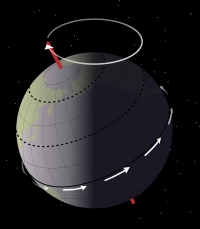Axial precession

Ok kiddo, so you know that the Earth spins around like a top. Right?
Now, when a top spins, it wobbles a little bit, right? The same thing happens with the Earth. The Earth isn't perfectly straight up and down as it spins; it wobbles a little bit. This wobbling of the Earth on its axis is called axial precession.
The Earth's axis is tilted at an angle of about 23.5 degrees. This tilt gives us our seasons. As the Earth orbits around the Sun, different parts of the Earth get more or less sunlight, which causes the seasons.
But the Earth's axis isn't always pointed in the same direction. It slowly wobbles in a circle like a spinning top. This wobbling takes about 26,000 years to complete one full circle.
Now, why does this happen? It's because of the gravitational pull of the Sun and the Moon on the Earth. The shape of the Earth isn't perfectly round, it's a little lopsided. This means that the gravitational pull of the Sun and the Moon isn't perfectly balanced on the Earth. This causes the Earth to wobble a little bit, and that's axial precession.
Axial precession is important because it affects the position of the stars in the sky. Over a long period of time, the stars appear to move in the sky because of the Earth's wobbling. This is why the North Star (Polaris) won't always be the North Star – in fact, in about 13,000 years, it will be Vega.
So, that's axial precession – the wobbling of the Earth's axis as it spins, caused by the gravitational pull of the Sun and the Moon.
Now, when a top spins, it wobbles a little bit, right? The same thing happens with the Earth. The Earth isn't perfectly straight up and down as it spins; it wobbles a little bit. This wobbling of the Earth on its axis is called axial precession.
The Earth's axis is tilted at an angle of about 23.5 degrees. This tilt gives us our seasons. As the Earth orbits around the Sun, different parts of the Earth get more or less sunlight, which causes the seasons.
But the Earth's axis isn't always pointed in the same direction. It slowly wobbles in a circle like a spinning top. This wobbling takes about 26,000 years to complete one full circle.
Now, why does this happen? It's because of the gravitational pull of the Sun and the Moon on the Earth. The shape of the Earth isn't perfectly round, it's a little lopsided. This means that the gravitational pull of the Sun and the Moon isn't perfectly balanced on the Earth. This causes the Earth to wobble a little bit, and that's axial precession.
Axial precession is important because it affects the position of the stars in the sky. Over a long period of time, the stars appear to move in the sky because of the Earth's wobbling. This is why the North Star (Polaris) won't always be the North Star – in fact, in about 13,000 years, it will be Vega.
So, that's axial precession – the wobbling of the Earth's axis as it spins, caused by the gravitational pull of the Sun and the Moon.
Related topics others have asked about:
